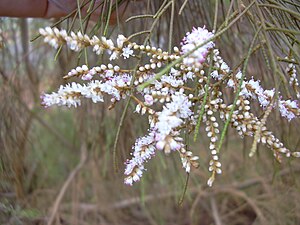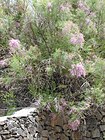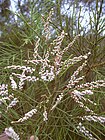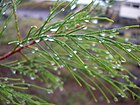Note: This is a project under development. The articles on this wiki are just being initiated and broadly incomplete. You can Help creating new pages.
Difference between revisions of "Tamarix aphylla"
(Created page with "{{stub}} ==Uses== {{Uses|}}, {{Uses|}}, {{Uses|}}, {{Uses|}}, {{Uses|}}, {{Uses|}}, {{Uses|}}, {{Uses|}}, {{Uses|}}, {{Uses|}}, {{Uses|}}.<ref name="Uses"/> ==Parts Used== {{...") |
|||
| Line 1: | Line 1: | ||
| − | + | [[File:Starr 030923-0212 Tamarix aphylla.jpg|thumb|right]] | |
| + | '''Athel tamarisk''' is an upright, evergreen tree with drooping twigs and a dense spreading crown with several heavy large limbs; it usually grows 8 - 12 metres tall, but occasional specimens up to 18 metres are recorded. The bole can be 60 - 80cm in diameter. | ||
==Uses== | ==Uses== | ||
| − | {{Uses|}}, {{Uses| | + | {{Uses|Eczema}}, {{Uses|Skin diseases}}.<ref name="Uses"/> |
==Parts Used== | ==Parts Used== | ||
| Line 16: | Line 17: | ||
===Dravya=== | ===Dravya=== | ||
===Rasa=== | ===Rasa=== | ||
| − | |||
===Guna=== | ===Guna=== | ||
| Line 29: | Line 29: | ||
==Habit== | ==Habit== | ||
| − | {{Habit|}} | + | {{Habit|Evergreen tree}} |
==Identification== | ==Identification== | ||
| Line 48: | Line 48: | ||
==Mode of Propagation== | ==Mode of Propagation== | ||
| − | {{Propagation|}} | + | {{Propagation|Seeds}}, {{Propagation|Cuttings of half-ripe wood}}, {{Propagation|Cuttings of mature wood}}. |
==How to plant/cultivate== | ==How to plant/cultivate== | ||
| − | <ref name="How to plant/cultivate"/> | + | A plant of the arid and semi-arid subtropics and tropics, where it is found at elevations up to 1,400 metres. It grows best in areas where annual daytime temperatures are within the range 27 - 40°c, but can tolerate 8 - 50°c.<ref name="How to plant/cultivate"/> |
==Commonly seen growing in areas== | ==Commonly seen growing in areas== | ||
| − | {{Commonly seen|}}, {{Commonly seen| | + | {{Commonly seen|Coastal scrubland in saline soils}}, {{Commonly seen|Sandy soil}}. |
==Photo Gallery== | ==Photo Gallery== | ||
<gallery class="left" caption="" widths="140px" heights="140px"> | <gallery class="left" caption="" widths="140px" heights="140px"> | ||
| − | + | Starr 010419-0066 Tamarix aphylla.jpg | |
| + | Athel tamarisk, Tamarix aphylla, 2013 - panoramio.jpg | ||
| + | Starr 030923-0205 Tamarix aphylla.jpg | ||
| + | Starr 041228-2479 Tamarix aphylla.jpg | ||
| + | Starr 030923-0212 Tamarix aphylla.jpg | ||
</gallery> | </gallery> | ||
| Line 64: | Line 68: | ||
<references> | <references> | ||
| − | <ref name="chemical composition">[ | + | <ref name="chemical composition">[Chemistry]</ref> |
| − | <ref name="Leaf">[ | + | <ref name="Leaf">[Morphology]</ref> |
| − | <ref name="How to plant/cultivate">[ | + | <ref name="How to plant/cultivate">[http://tropical.theferns.info/viewtropical.php?id=Tamarix+aphylla Cultivation]</ref> |
<ref name="Uses">Indian Medicinal Plants by C.P.Khare</ref> | <ref name="Uses">Indian Medicinal Plants by C.P.Khare</ref> | ||
</references> | </references> | ||
==External Links== | ==External Links== | ||
| − | * [ ] | + | * [https://keyserver.lucidcentral.org/weeds/data/media/Html/tamarix_aphylla.htm Tamarix aphylla on keyserver.lucidcentral.org] |
| − | * [ ] | + | * [https://www.cabi.org/isc/datasheet/52483 Tamarix aphylla on cabi.org] |
| − | + | ||
[[Category:Herbs]] | [[Category:Herbs]] | ||
Revision as of 17:38, 18 August 2020
Athel tamarisk is an upright, evergreen tree with drooping twigs and a dense spreading crown with several heavy large limbs; it usually grows 8 - 12 metres tall, but occasional specimens up to 18 metres are recorded. The bole can be 60 - 80cm in diameter.
Contents
- 1 Uses
- 2 Parts Used
- 3 Chemical Composition
- 4 Common names
- 5 Properties
- 6 Habit
- 7 Identification
- 8 List of Ayurvedic medicine in which the herb is used
- 9 Where to get the saplings
- 10 Mode of Propagation
- 11 How to plant/cultivate
- 12 Commonly seen growing in areas
- 13 Photo Gallery
- 14 References
- 15 External Links
Uses
Parts Used
[[:Category:Herbs with used in medicine|]], stem, leaves, Root.
Chemical Composition
Common names
| Language | Common name |
|---|---|
| Kannada | |
| Hindi | |
| Malayalam | |
| Tamil | |
| Telugu | |
| Marathi | |
| Gujarathi | |
| Punjabi | |
| Kashmiri | |
| Sanskrit | |
| English |
Properties
Reference: Dravya - Substance, Rasa - Taste, Guna - Qualities, Veerya - Potency, Vipaka - Post-digesion effect, Karma - Pharmacological activity, Prabhava - Therepeutics.
Dravya
Rasa
Guna
Veerya
Vipaka
Karma
Prabhava
Habit
Identification
Leaf
| Kind | Shape | Feature |
|---|---|---|
Flower
| Type | Size | Color and composition | Stamen | More information |
|---|---|---|---|---|
| {{{5}}} |
Fruit
| Type | Size | Mass | Appearance | Seeds | More information |
|---|---|---|---|---|---|
Other features
List of Ayurvedic medicine in which the herb is used
Where to get the saplings
Mode of Propagation
Seeds, Cuttings of half-ripe wood, Cuttings of mature wood.
How to plant/cultivate
A plant of the arid and semi-arid subtropics and tropics, where it is found at elevations up to 1,400 metres. It grows best in areas where annual daytime temperatures are within the range 27 - 40°c, but can tolerate 8 - 50°c.[4]
Commonly seen growing in areas
Coastal scrubland in saline soils, Sandy soil.
Photo Gallery
References
- ↑ Indian Medicinal Plants by C.P.Khare
- ↑ [Chemistry]
- ↑ [Morphology]
- ↑ Cultivation
External Links
- Ayurvedic Herbs known to be helpful to treat Eczema
- Ayurvedic Herbs known to be helpful to treat Skin diseases
- Herbs with used in medicine
- Herbs with stem used in medicine
- Herbs with leaves used in medicine
- Herbs with Root used in medicine
- Habit - Evergreen tree
- Index of Plants which can be propagated by Seeds
- Index of Plants which can be propagated by Cuttings of half-ripe wood
- Index of Plants which can be propagated by Cuttings of mature wood
- Herbs that are commonly seen in the region of Coastal scrubland in saline soils
- Herbs that are commonly seen in the region of Sandy soil
- Herbs





